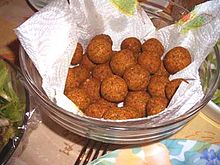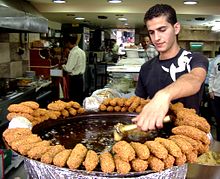Falafel

Falafel (Arabic: فلافل , or in Egyptian and Sudanese Arabic, طعمية Ta'miyya) is a fried ball or patty made from spiced fava beans and/or chickpeas. It is a popular form of fast food in the Middle East, where it is also served as a mezze.
The Arabic word "falafel" (falāfil) is the plural of فلفل ([filfil] Error: {{Lang}}: text has italic markup (help)) 'pepper'.[1] Variant spellings in English include felafel and filafil.
Falafel is usually served in a pita-like bread called Arabic bread, either inside the bread, which acts as a pocket, or wrapped in a flat bread. In many countries falafel is a popular street food or fast food. The falafel balls, whole or crushed, may be topped with salads, pickled vegetables and hot sauce, and drizzled with tahini-based sauces. Falafel balls may also be eaten alone as a snack or served as part of a mezze. During Ramadan, they are sometimes eaten as part of an iftar, the meal which breaks the daily fast after sunset.
Falafel has been part of the diet of Egyptians and the people of the Middle East for centuries.[2]
History
The actual origins of falafel are not certain; according to the Hebrew-language paper, Ynetnews, "A possible theory suggests falafel was invented some 1000 years ago by the Egyptian Copts, who brought it with them to the rest of the Middle East."[3] Originally made with fava beans, the dish migrated northwards to Syria and Palestine, chickpeas were introduced instead.[2] The chickpea was used as a food item in the Levant before 4000 BC.[4]
Ingredients
Falafel is made from fava beans or chickpeas or a combination of the two. The Egyptian variation uses fava beans exclusively, while other variations may only use chickpeas. Falafel made exclusively from chickpeas became popular in Israel because of favism, a potentially fatal genetic disease among some Mediterranean Jews causing a hemolytic reaction to fava beans. It is also important to note that Arabs in Jerusalem and Yemenite Jews have historically made their falafel from only chickpeas, a technique that existed among them even before the establishment of Israel.[5] Unlike many other bean patties, in falafel the beans are not cooked prior to use. Instead they are soaked, possibly skinned, then ground with the addition of a small quantity of onion, parsley, spices (including cumin), and bicarbonate of soda, and deep fried at a high temperature. Sesame seeds may be added to the balls before they are fried; this is particularly common when falafel is served as a dish on its own rather than as a sandwich filling.
Recent culinary trends have seen the chickpea falafel have more success than fava bean falafel. Chickpea falafels are served across the Middle East, and have been popularized by expatriates of those countries living abroad. However, fava-bean falafel continue to predominate in Egypt and Sudan and their respective expatriate communities, and Egyptians are fond of deriding chickpea falafel as inferior.[citation needed]
In Israel small 2 1/2 cm spherical balls are made, while in Egypt and among Palestinians larger patties are shaped with a tablespoon or a special scoop with a lever to release them into the hot oil.
Variations

Outside the Middle East, pita bread is often used as a pocket and stuffed with the different ingredients; in Arab countries a round khubz bread, 'eish' in Egypt, is halved, and the two resulting round pieces are used to create a cigar-shaped wrap. In Arab countries, hummus (chickpeas pureed with tahini) is rarely used as a condiment, the usual sauce being tahini (sesame seed paste) thinned with water and lemon. The most common salad ingredients are tomato and parsley. In Lebanon, parsley is mixed with chopped mint leaves. It is also common in Syria and Lebanon to add pickles; the two canonical ones are pickled turnip, colored pink with beetroot, and pickled cucumber. Recently, there has been a new "filled" falafel, its center usually consisting of ground meat or minced onions or a boiled egg. These fillings are wrapped by the uncooked falafel mixture, and then deep fried.
The salads or the pita itself may be seasoned with sumac or salt; alternatively, these may be sprinkled on top. In Syria, sumac is widely used.
Related dishes
- In the cuisine of Karnataka, ambode is a fried ball of soaked chickpeas. It is usually flattened and pan-fried, and served with chutney. Alternatively, in South Indian cuisine, paruppu vadai(Tamil)/pappu vadaa/masala vadaa(Telugu) is used to refer to flattened, fried balls (or fritters) of a mix of lentils and chickpeas. Different kinds of lentil mixtures are used, including mung beans.
- Dahi vada is a spiced fritter of fried, soaked lentils served in chilled yoghurt (dahi). The recipe can be the same as felafel (chickpeas, onion, cumin).
- In Italian cuisine, there is a chickpea fritter called frittata di ceci; other similar Italian dishes include panelle and farinata.
- Acarajé, an Afro-Brazilian street food from the northeastern state of Bahia, are pureed black-eyed peas formed into a ball and then deep-fried in palm oil.
See also
References
- ^ “Falafel.” The American Heritage Dictionary of the English Language, 4th ed. Boston: Houghton Mifflin, 2000. Accessed on April 6, 2006.
- ^ a b Jodi Kantor (July 10, 2002). "A History of the Mideast in the Humble Chickpea". The New York Times. Retrieved 2008-03-23.
{{cite web}}: Italic or bold markup not allowed in:|publisher=(help) - ^ Falafels: Fact Sheet (accessed 21-08-2008)
- ^ Brothwell & Brothwell pp. 105-7
- ^ About Israel's signature food--plus, a recipe.
